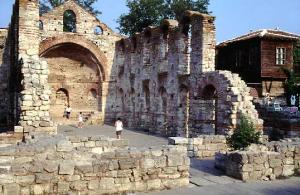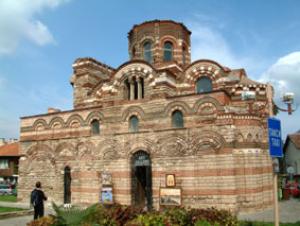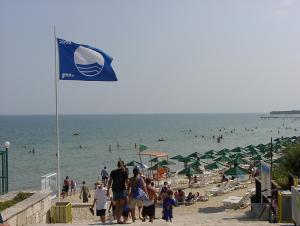Nessebar information, Bulgarian black sea beach resorts
Nessebar PropertiesThe town of Nessebar has 9437 inhabitants. It is situated on a small peninsula and on the land jutted out into the sea, 37 km north-east of Bourgas and 429 km east of Sofia. Its beach is considered to be the best along the Black Sea coast. The big sandy strip of land between the town and the village of Ravda is covered with extremely fine and abundant clean golden sand. There are marvellous dunes next to the coast. The green copses by the sandy strips provide a cool breath of air during the hot days.
Watch a high quality video that we made of the old town of Nessebar and the surroundings.
The town was founded on the place of a Thracian fisherman?s settlement that was named Menabryia, which meant the town of Mena (the founder of the settlement). In the 6th century BC it was a colony of the Megarus tribe from ancient Greece, immigrants from Byzantium and Kalhedon. It remained the only Doric colony along the Black Sea coast, as the rest were typical Ionic colonies.
The Greeks named it Messembria and it grew into a big and well-fortified town-state with natural protection both from the land and the sea. It was equipped with water mains, a system of sewers, fortified walls, amphitheatre and numerous cult buildings the most impressive of which was the temple of Apollo. It became a commercial centre and plenty of goods from the Aegean and the Mediterranean basins were traded there. The excavated objects testify to a brisk trade with the ancient world.
The town maintained excellent relations with the neighbouring Thracian tribes and minted its own coins in 5th century BC. Two centuries later it grew so much that it founded its own colony called Navlohos near Obzor. The whole land between Nessebur and Obzor used to be a granary that supplied the two colonies with food as well as products of exchange and import. In 1st century BC the town fell under Roman rule and surrendered to Marcus Lukulus? legions so that it did not suffer any devastation. It was then that the constructions of the second colony of Messembria began, to the south of it - Anhialo (present day Pomorie).
In the early Middle Ages the town restored the fortress walls and until 812 it was part of Byzantium. In the same year it was conquered by Khan Kroum with no resistance put up, and was included in the territory of Bulgaria. Many a time the town was under the rule of the Bulgarians and then in the hands of the Byzantines.
During the reign of Ivan Alexander the town reached its cultural and economic boom, and it grew to the extent of occ
 upying a huge territory of the land beyond the peninsula. It was approximately in this period of time when most of the churches of Nessebur were built and up to this day they are a unique decoration of the town. According to the world statistics Nessebur is the town having the biggest number of churches per capita.
upying a huge territory of the land beyond the peninsula. It was approximately in this period of time when most of the churches of Nessebur were built and up to this day they are a unique decoration of the town. According to the world statistics Nessebur is the town having the biggest number of churches per capita.In 1366 the knights of Amadeus of Savoy conquered and devastated the town, and then sold it to Byzantium for 15 000 golden ducats. In 1453 shortly after Constantinople fell under Turkish domination the town was conquered by the Ottoman Empire and suffered decay. At the dawn of the Liberation it was a dilapidated fishermen?s settlement, with well-developed viticulture on the soft hills above the town.
Today Nessebur is one of the resorts most preferred by tourists and it has been most attractive ever since the beginning of the century. The constructions of the new town started at the time together with numerous rest homes, big and small hotels, and modern facilities for tourism and entertainment. The old buildings were restored and new houses in ancient style were built.
The churches in Nessebur are 41. Not all of them have preserved their full brilliance but even their present condition strongly impresses tourists. One of the oldest sights is the Basilica situated on the seashore, built most probably at the beginning of 5th century. The building had three naves, however only the foundations have remained today. The Old Bishop?s Residence located in the centre of the town is probably the most imposing one of all the churches in Nessebur. It is more than 25 m long and 22 m wide.
The three naves were decorated with a colonnade and arches; stone and brick laid with a mosaic covered
floor. St. John the Baptist Church was built in 11th century and is a typical cross domed church with three naves, and four brick-laid columns supporting the whole dome. There are some fragments of frescoes preserved dating back to 13th century. There is a small archaeological museum arranged in the church.
The St. Stefan Church or the so-called New Bishop?s Residence was built in 10th century, too, and is situated in the vicinity of the harbour.
 It is three-nave. The exterior decoration is so picturesque that it marked the beginning of the future typical style of Nessebur expressed in the construction and decoration of churches of later times. The facade of the church is ornamented with built-in meanders of glazed ceramic figures of different colours, maiolicas and enamelled tiles that at the same time adorn and distinguish the architectural components. The main frescoes here were painted in 14th-15th centuries. The bishop?s throne and the altar were made of wood later in 17th century.
It is three-nave. The exterior decoration is so picturesque that it marked the beginning of the future typical style of Nessebur expressed in the construction and decoration of churches of later times. The facade of the church is ornamented with built-in meanders of glazed ceramic figures of different colours, maiolicas and enamelled tiles that at the same time adorn and distinguish the architectural components. The main frescoes here were painted in 14th-15th centuries. The bishop?s throne and the altar were made of wood later in 17th century.The subsequent picturesque style was best illustrated in the St. Todor Church; however only two facades have been preserved in their initial style. Today it has been restored, but the preserved decoration elements are unique in shape, colour, and variety of component combination. The St. Paraskeva Church was built in the same style. It is a small one-nave church. The ornaments match the archi-tec-tonics of the building in a most natural way. Consoles with tiny arches slightly support the upper part of the dome and resemble children?s sandcastle. The St. Archangels Michail and Gavrail Church used to have a dome; its remains evidence of an interesting project and excellent performance. The restoration enables the tourists see the architectural conception in the typical picturesque style.
In the ideal centre of the town itself is the Pantocrator Church with domes on a rectangular foundation. The St. Yoan Aliturgetos Church is considered to be the most beautiful one perched high above the harbour. It has three naves and the decoration of the facades is of unique beauty, particularly the eastern one facing the sea.
The remains of many parts of fortress walls have been found as well as the square turret, the round turret, a large part of the authentic medieval street pavement, and some of the Roman and Greek pavements, fortifications of different times and epochs, remains of administrative and other kinds of buildings. In spite of its small size the town is ever surprising tourists with the antiquities appearing all over the place.
During the Turkish rule only one church was built in 17th century ? the St. Spas Church. The typical houses of Nessebur built in the unique style of 16th-19th centuries are interesting architectural monuments. So are the houses of Diamanti and that of Panayot Mouskoyani, which hosts an ethnographic exhibition, and that of Captain Pavel. The whole ensemble of the old quarters of Nessebur shows remarkable taste and mastership in the construction of houses, stone walls, and streets. The Turkish bath and the windmill at the beginning of the causeway are of particular interest.
 The most famous hotels in the town are Messembria Hotel, Globus Hotel and Bourgas Hotel. In the town there is a tourist house and lots of small hotels.
The most famous hotels in the town are Messembria Hotel, Globus Hotel and Bourgas Hotel. In the town there is a tourist house and lots of small hotels.Private lodgings can be found without reservation in the old town; the inhabitants themselves offer their services to the tourists arriving to the town.
There is a regular transport connecting Bourgas and Pomorie to Nessebur and Slaunchev Bryag (Sunny Beach). There are private taxis typical for the seaside towns due to the great number of tourists. The prices are moderate. There is water transport to Bourgas; one can often hire local boatmen to reach various places in the bay.
There is a regular transport connecting Bourgas and Pomorie to Nessebur and Slaunchev Bryag (Sunny Beach). There are private taxis typical for the seaside towns due to the great number of tourists. The prices are moderate. There is water transport to Bourgas; one can often hire local boatmen to reach various places in the bay.
The village of Ravda is situated south of Nessebur and a sand strip connects both. There are melon fields, vines and gardens near the village where one can buy fresh agricultural products at low prices. There are numerous children?s and youth camps, holiday houses and private lodgings. The village of Aheloy is situated on the motorway to Bourgas near the mouth of the Aheloy River. This is where the Bulgarian Tsar Simeon I destroyed the armies of the Byzantine emperor Lion Foka in the area called nowadays Kokalos because of the scattered bones of the killed soldiers. A vast firth with a sand strip parallels the distance from here to Pomorie and the long beach of excellent category is not yet built up. It borders the firth of Pomorie and the salt-mines by the town.
Nessebar Properties

